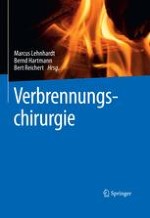Zusammenfassung
Thermische Verletzungen sind häufige Verletzungen im Kindesalter. In Deutschland gibt es 18 Zentren für schwerbrandverletzte Kinder (Stand 2016). Diese Krankenhäuser stellen nominell 46 Betten zur Verfügung. Vom Arbeitskreis »Das brandverletzte Kind« werden jährlich die Patientenzahlen der 19 Zentren für schwerbrandverletzte Kinder sowie in sechs weiteren Kliniken erfasst. Von den etwa 1900 pro Jahr in diesen Kliniken behandelten Patienten sind >60 % unter 3 Jahre alt, etwa 20 % sind jünger als ein Jahr. In mehr als 70 % der Fälle handelt es sich um Verbrühungen, am zweithäufigsten sind Kontaktverbrennungen. Verbrennungen durch Flammen sind deutlich seltener, Verletzungen durch Strom oder Explosionen stellen Raritäten dar. Der Großteil der Verletzungen hat ein Ausmaß <10 % der Körperoberfläche. In diesem Kapitel werden die Besonderheiten der Versorgung brandverletzter Kinder beschrieben – aus notärztlicher, anästhesiologischer, pädiatrischer und chirurgischer Perspektive.











